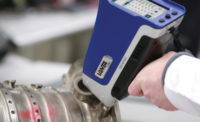
Easily verify warehouse materials using handheld XRF. Source: Thermo Scientific Niton Analyzers
The verification of metal alloys for manufacturing quality assurance and control has never been more important for product reliability and safety. From nondestructive testing (NDT) inspections in petrochemical refineries to pharmaceutical plants and medical device manufacturing, metal production to service centers and distributors, and component fabrication to final product assembly, the potential for material mix-ups is very real, and the need for traceability is now a priority. In some cases, the use of incorrect alloys has resulted in significant injuries and even death.
In order to maintain quality control, keep the answers to the following questions in mind:
1. What technology is available so I can take better control of my material verification?
The ability to verify specific alloys at delivery, prior to fabrication, and during final product assembly and inspection has become a vital part of many companies’ quality assurance (QA) programs. Handheld X-ray fluorescence (HHXRF) is an indispensible tool in these QA programs since it provides a rapid and completely nondestructive method for verifying specific alloys and their chemistries.
2. What is handheld X-ray fluorescence?
Handheld X-ray fluorescence is an elemental analysis technology that uses the X-ray’s ability to excite or ionize atoms by ejecting inner-shell electrons. When these excited atoms return to a stable energy state by filling the voids left by the ejected electrons, they emit fluorescent X-rays.
HHXRF analyzers provide the X-ray excitation source for ionization and simultaneously detects the resultant fluorescent X-rays from the sample. The energy level of these X-rays is a “signature” of the individual elements that release it. Counting the amount or flux of these X-rays determines the concentration level of that particular element. Using an advanced alloy library, HHXRF instruments can link the elements present and their respective concentrations to the exact alloy you are analyzing.
3. What alloys can I identify using this technology?
Today, almost all alloys can be analyzed using HHXRF. These include low-alloy; stainless and tool steels; Co, Ni and other super-alloys; titaniums, aluminums, copper, brass and bronze alloys; precious metals; and other exotic alloys.
Though there are an estimated 70,000 alloy grades, the most common alloys can be narrowed down to several hundred. The most advanced HHXRF analyzers will have the majority of common alloys built into its library. Even if the alloy undergoing analysis is not in the library, most instruments will display accurate chemistries and allow operators to add or modify the library for their specific needs.

Primary X-ray energy is produced by the handheld XRF analyzer and directed at the sample surface, causing inner-shell electrons to be ejected from their orbits in individual atoms and releasing a signature fluorescent X-ray. Source: Thermo Scientific Niton Analyzers
The more advanced analyzers on the market can provide some level of coating thickness measurement on known substrates and coating layers. Multiple layers of discrete coatings can be measured simultaneously. This use of HHXRF can help prevent under-coating, which can lead to early corrosion or other product failures, or over-coating, which can be costly and result in blemishes or other defects. It also can be used simply to verify the presence of coating layers under the top coat for QA.
5. Can it be used to analyze welds and other small components?
Weld analysis is a critical part of any quality control program in the fabrication industry. Proper verification of the parent and weld material should be the first step prior to the welding procedure. After the weld is completed, HHXRF can be used to analyze the weld to verify proper dilution of the parent and weld materials into the weld itself.
To ensure that you are analyzing only the weld, some analyzers come with either a snap-on nose piece or built-in small-spot collimation.
6. What features should I look for in a handheld XRF analyzer?
a. Choice between Si-PIN and Si-Drift Detectors (SDD).
Not all detectors are created equal. Si-PIN (or “Silicon Pin”) detectors provide the most economical solution for HHXRF, but they do not come near to having the resolution or sensitivity of SDDs. For instance, if an application requires light element detection capabilities, for example, Mg, Al, Si, P, S, you should invest in an analyzer with an SDD. In general, the larger the SDD, the greater sensitivity your analyzer will have, but there are also other design features that will impact analyzer performance such as X-ray tube voltage and filter configurations.
b. Accurate chemical analysis and robust calibration.
These two points go hand-in-hand. Without a strong calibration technology, an analyzer will not provide accurate chemistries, resulting in incorrect alloy identification. An empirical calibration generally provides very good results for specific alloys, while a robust fundamental parameters (FP) calibration will provide the overall accuracy over the largest range of alloy grades.

A charge-coupled device camera and small-spot feature locate and isolate small sample areas for analysis. Source: Thermo Scientific Niton Analyzers
Often, HHXRF analyzers are used continuously throughout a shift in an industrial environment or even outdoors and exposed to the elements. The instrument should be sealed to prevent dust and moisture damage.
Additionally, it should have few or no removable parts required for operation because they can easily be lost or left in an area inconvenient to the work area. These may include PDAs, check standards and docking stations.
Further, there should be sufficient battery life so the need to replace them during the course of a shift limits unnecessary downtime.
Last, the analyzer also should have a comfortable feel in your hand and have a display that is large, easy to read, and angled or adjustable to a position for easy viewing.
d. Reliable software and operating system that is easy to use.
Having an operating system and software that is stable and resistant to crashes helps eliminate downtime. Each analyzer on the market today has different software and may make use of differing operating systems, so choose the one that you feel provides the simplest operation and the best reliability.
Having analysis data that is tamperproof (not just encrypted, which can be compromised) ensures the integrity of your data for future reference. The analyzer’s software should have the capability to export analysis data into MS-Excel or other formats, as well as the ability to print reports and certificates of analysis.
e. Fast and accurate alloy analysis and identification.
In any operation, time is money. The analyzer you use should not only accurately identify your alloys, but do it quickly to avoid excess inspection time and employee fatigue. Even more important is its ability to accurately identify alloys with few to no errors.
When considering the purchase of an analyzer, have prospective vendors come on-site and test them on your alloys. Pay close attention to chemical accuracy against known standards, the analyzer’s ability to identify the alloys you use and how fast the analyzer makes the correct identification.
Armed with the answers to these six questions-and a handheld XRF analyzer-should help put you in control of your positive material verification and elemental analysis needs.NDT

